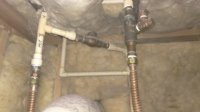JOD
New Member
Greetings, and thanks for the awesome forum! I have an odd plumbing question, along with quick backstory:
The water heater is also the supply for radiant heat--so it's running a lot. It's about 15 years old, no problems. It was installed by a general contractor who did the plumbing himself.
Suddenly I noticed some leaking water. The water is leaking from an uncapped elbow coming off of the cold water supply line? In hours of combing the interwebs, I have not seen anything ever plumbed in this manner? There IS an expansion tank, also plumbed in a manner that I've never seen. There is a mixing valve with the hot water supply, and then the expansion tank goes off of that. I'm including a picture--the tank is just out of sight to the left, but you can see how it's plumbed.
First off, I'm wondering how this uncapped elbow wasn't leaking all along? Secondly, I'm wondering what's causing the leak. Other notes:
-the pressure relief valve seems to be working
-the dripping slowed after a let out some water
-the expansion tank is now pressurized at 60psi, was showing 40 (60psi supply to the house)
Note: the smaller diameter tubing in the back from the mixing valve then goes to the expansion tank.
I would ask my friend who did the plumbing what he had in mind with the elbow vent, but sadly he's deceased. Any and all thoughts are welcome!
The water heater is also the supply for radiant heat--so it's running a lot. It's about 15 years old, no problems. It was installed by a general contractor who did the plumbing himself.
Suddenly I noticed some leaking water. The water is leaking from an uncapped elbow coming off of the cold water supply line? In hours of combing the interwebs, I have not seen anything ever plumbed in this manner? There IS an expansion tank, also plumbed in a manner that I've never seen. There is a mixing valve with the hot water supply, and then the expansion tank goes off of that. I'm including a picture--the tank is just out of sight to the left, but you can see how it's plumbed.
First off, I'm wondering how this uncapped elbow wasn't leaking all along? Secondly, I'm wondering what's causing the leak. Other notes:
-the pressure relief valve seems to be working
-the dripping slowed after a let out some water
-the expansion tank is now pressurized at 60psi, was showing 40 (60psi supply to the house)
Note: the smaller diameter tubing in the back from the mixing valve then goes to the expansion tank.
I would ask my friend who did the plumbing what he had in mind with the elbow vent, but sadly he's deceased. Any and all thoughts are welcome!

